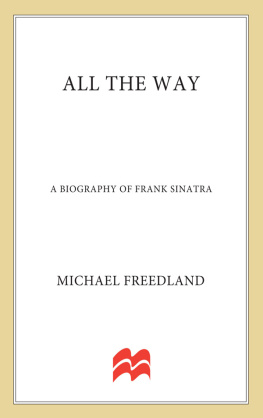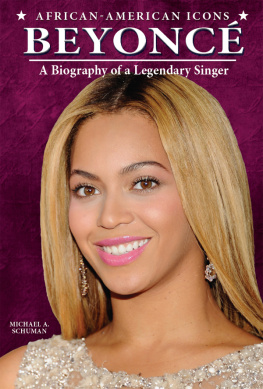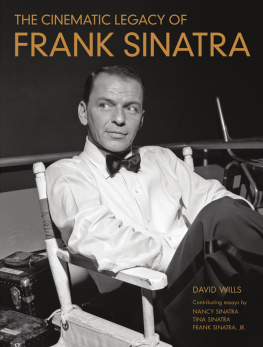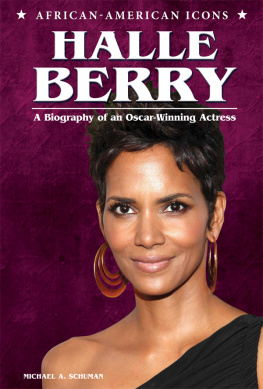Contents
Guide
ALL THE WAY
A Biography of Frank Sinatra
Michael Freedland
St. Martins Press  New York
New York
The author and publisher have provided this e-book to you for your personal use only. You may not make this e-book publicly available in any way. Copyright infringement is against the law. If you believe the copy of this e-book you are reading infringes on the authors copyright, please notify the publisher at: http://us.macmillanusa.com/piracy.
For Beth and Elinor
who have brought such joy
There never was anyone like Sinatra.
Certainly, there have been other entertainers who have made love to their audiences and earned their adoration in return. There have been other performers who literally bruised their way into the public attention but were so magnetic, so articulate, that any misdemeanours were soon forgiven. There have been showmen who so lived for the spotlight that they then tried to find ways of bottling it all up and taking it away with them. There have been other vocalists whose singing faded along with the colour of their hair and yet who still kept going as though their voices were cut from the same old velvet that had long gone threadbare simply because paying customers were still being mesmerised.
Only Sinatra was all of those things. Frank Sinatra? The first name has been superfluous ever since they stopped calling him Frankie, which is an immortality of sorts. Francis Albert? Thats there to be used by fawning near-celebrities who are afraid of the consequences of addressing him as Ol Blue Eyes.
So is Sinatra a collection of clichs? Yes, except that he created them and all of them about himself.
There has to be some secret for a man to sell records by the million, fill the biggest concert venues in the world, make more than a handful of movies which were memorable, and yet still have the reputation and manners of a prizefighter. There had to be an audience out there who defined Sinatras unique kind of megastardom. Was it simply a question of love? It wasnt a marriage between public and performer, more a sixty-year-old affair with every episode, from foreplay to the final consummation, performed in front of a microphone.
Everyone in Sinatras life has been a participant in that affair.
Hoboken isnt exactly paradise, even if now they are trying to gentrify it, a word that would have been unknown and totally inexplicable to the people living in this grimy little New Jersey city eight decades ago.
Today, there are flowers in tiny front gardens where once there had only been trashcans. There are pictures on walls where once the sole colour had come from the blood of kids and much older men the ones who daily had been forced up against the brickwork in the course of being made offers they couldnt possibly refuse.
The ferries still ply the Hudson River to and from Manhattan. These days, you can also take a train and get there in ten minutes. The journey isnt so pleasant in summer, but in the winter when the cold is so bitter that you find yourself envying a hibernating tortoise, those ten minutes are to treasure. This is not a town helped by its climate. Today when virtually every house and apartment has enough radiators to provide warmth in winter and air conditioners to cool the heat of summer, the weather plays less of a part in Hoboken life than once it did. But in the first three decades of the century, existence could be hard in a place where snow comes in November and lasts till March, and the only refuge from the stifling heat of July and August was to dance in the spray of a fire hydrant by day and sleep on a fire escape by night.
Hoboken has always been an insular sort of place. There are still people who have never been further than across the Hudson to New York and at least one man who has never even left New Jersey. Although an urban village, the inhabitants know each other as well as if Hoboken were a farming community in the middle of a Kansas plain; it is a place where, at one time, a couple living in sin would have caused as much of a stir as a country-town librarian taking a secret lover.
Familiarity is bred by size or at least by the lack of it. From the ferry stop or the train station, take a taxi to anywhere in town and it is always four dollars. Hoboken is still only a mile square, just as it was when Francis Albert Sinatra all thirteen-and-a-half pounds of him fought his way into the world and confounded the doctor, the midwife and, not least of all, his twenty-year-old mother, Dolly.
Dolly, born Natalie Catherine Garavente, didnt look big enough to carry a sack of potatoes that heavy. She weighed no more than ninety pounds. No one in the room that day in December 1915 expected her to survive. Everyone thought that the baby with the lacerated earlobe and cheeks along with a punctured eardrum, the result of being wrenched out of the birth canal with all the finesse of a plumbers mate using a pair of pliers was dead. In fact, he would have been, had Dollys mother Rosa, who ran a grocery store, not also been a part-time midwife. She held the baby under the cold-water tap until he screamed.
This was Hoboken in 1915, and the city has changed little over the years, even if todays gentrified population of 30,000, boosted as it is by the commuters taking those ferry trips and train rides, is only half the number it was. The legacy of the past fingers among the few families who still remember the Sinatras along with the dirt and the squalor and the fights.
Not for nothing was this town the setting for On the Waterfront, the 1950s Marlon Brando film of union wars and corruption among the stevedores and longshoremen, a movie which almost might have been remembered as the Frank Sinatra film, a story to come later in this tale of the man who is regarded as Hobokens favourite son at least by some. Others have not forgiven him and doubtless never will. For what? For slighting the town of his birth during his greatest years? Or just for being the most successful entertainment figure American ever knew?
Let us begin with his name. Like almost every Frank Sinatra story, there is more than one version. A birth certificate records the arrival on 12 December 1915 of Frank Sinestro. The surname could only have been a misprint. When a new copy was issued more than twenty years later, the name was changed to Francis A. Sinatra. There is no doubt that Sinatra was the family name; but did his parents later wonder whether Francis didnt sound a little nicer than Frank? And the A? Was his middle name always Albert? Or did he copy Harry Truman and later find something to fit an initial? (In 1976 the matter was made official. The Officer of the Registrar of Vital Statistics issued yet another birth certificate this time, the name was given as Francis Albert Sinatra.)
The notion that Frank came before Francis is supported by the fact that although the family proudly spoke about naming the child after the saint, his father Martys dear friend and fellow amateur baseball player Frank Garrick always said the name was in honour of himself. Not only that; Garrick was chosen as the babys godfather at the christening on 2 April 1916 appropriately at St Franciss Church in Hoboken.
In these facts, too, there are no more certainties than in anything else concerning Sinatras early years. According to legend, he was to have been named Martin after his father, Anthony Martin Sinatra but the priest, having asked for the name of the godfather, got confused and called him Frank. However, it is hard to imagine the Sinatra parents, especially powerful Dolly, allowing something like this to occur. If she had really wanted to call her son Martin, she would surely have corrected the priest.









 New York
New York